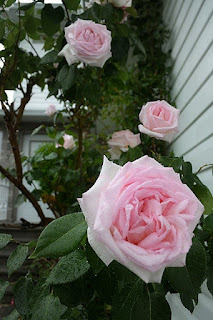shall adorn thy dells."
(David MacBeth Moir 1798-1851)
Glove-of -Fox, fairy cap, petticoats, fairy thimbles......by whatever name you know it, the foxglove is a romantic, beautiful biennial. Beatrix Potter drew them frequently all thru her stories.
Seeding freely when incredibly happy in its environment, the Foxglove is one of the most distinctive wildflowers.
You never know where it will come up each year. It's a wild thing. Loves dappled shade and variegated light throughout the day.
Its flower tubes are tinged and spotted , the bells hanging from every side, every which way.
Most foxgloves love to live next to ferns and woodland greenery. It takes two years for the plant to reach maturity where it will make flowers, but is well worth the wait.
Always good to let them seed themselves, every year. If you want more,Not everyone likes them.
"In the green part with the wooden palings , the wooden palings so hard to climb, there are fern and foxgloves, and primrose and violet, and green things growing all the time. "
( Edith Nesbitt 1858-1924)
In 1775, A doctor, named William Withering, was given a secret recipe , using extract of Foxglove. A woman from Shropshire ( located on the English Welsh border) was said to have given to him.
Withering lived at the time of the French and American revolution, of Mozart and Beethoven and Voltaire.
This extract was used to treat Dropsy, something we call congestive heart failure. It was a special secret remedy, that was brewed into a tea.
Withering experimented on patients who had no other hope, no other resource. From what I read in 1785 account, the foxglove tea was their last recourse.
"It has a power over the emotion of the heart, to a degree yet unobserved in any other medicine.This power may be converted to salutory ends." (W. Withering, Account of the Foxglove, 1985)
The Foxglove was always considered by some to be known only to the fairies, part of myth and lore, to be treated with great respect and care.
William Withering discovered that it was life altering.
Prior to his finds, doctors treated severe heart problems with bleeding, blistering, infusing with garlic, and a whole lot of ale to wash down the garlic......
Foxgloves bloom from June to September, for the most part. Depending on where they live in the garden.
One plant produces about 2 million seeds in its lifetime.
And grow up to 80 or more bell like flowerets on tall spikes that loom into the realm of the hanging basket...
It is a toxic plant that even the animals avoid.
Best to not disturb the foxglove; leave the stalks alone so they'll re-seed.


I've heard of some gardeners tearing them out completely,in fear of their toxic qualities. But I think there's no need. If you tear them out the fairies won't have any hats .......
"Let me thy vigil keep amongst boughs pavilioned, where the deer's swift leap startles the wild bee from the Foxglove bell."
(John Keats 1795-1821)























No comments:
Post a Comment